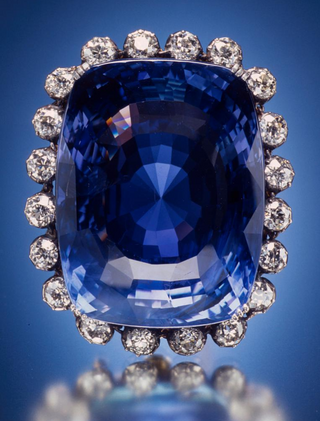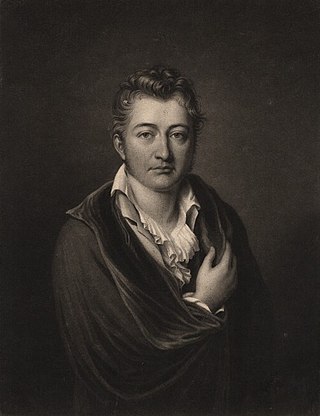Related Research Articles

A gemstone is a piece of mineral crystal which, when cut or polished, is used to make jewelry or other adornments. However, certain rocks and occasionally organic materials that are not minerals are also used for jewelry and are therefore often considered to be gemstones as well. Most gemstones are hard, but some soft minerals are used in jewelry because of their luster or other physical properties that have aesthetic value. Rarity and notoriety are other characteristics that lend value to gemstones.

Sapphire is a precious gemstone, a variety of the mineral corundum, consisting of aluminium oxide (α-Al2O3) with trace amounts of elements such as iron, titanium, cobalt, lead, chromium, vanadium, magnesium, boron, and silicon. The name sapphire is derived via the Latin sapphirus from the Greek sappheiros (σάπφειρος), which referred to lapis lazuli. It is typically blue, but natural "fancy" sapphires also occur in yellow, purple, orange, and green colors; "parti sapphires" show two or more colors. Red corundum stones also occur, but are called rubies rather than sapphires. Pink-colored corundum may be classified either as ruby or sapphire depending on locale. Commonly, natural sapphires are cut and polished into gemstones and worn in jewelry. They also may be created synthetically in laboratories for industrial or decorative purposes in large crystal boules. Because of the remarkable hardness of sapphires – 9 on the Mohs scale (the third hardest mineral, after diamond at 10 and moissanite at 9.5) – sapphires are also used in some non-ornamental applications, such as infrared optical components, high-durability windows, wristwatch crystals and movement bearings, and very thin electronic wafers, which are used as the insulating substrates of special-purpose solid-state electronics such as integrated circuits and GaN-based blue LEDs. Sapphire is the birthstone for September and the gem of the 45th anniversary. A sapphire jubilee occurs after 65 years.

The Hope Diamond is a 45.52 carats diamond extracted in the 17th century from the Kollur Mine in Guntur, India. It is blue in color due to trace amounts of boron. Its exceptional size has revealed new information about the formation of diamonds.

Jean-Baptiste Tavernier (1605–1689) was a 17th-century French gem merchant and traveler. Tavernier, a private individual and merchant traveling at his own expense, covered, by his own account, 60,000 leagues in making six voyages to Persia and India between the years 1630 and 1668. In 1675, Tavernier, at the behest of his patron Louis XIV, published Les Six Voyages de Jean-Baptiste Tavernier.

The French Crown Jewels and Regalia comprise the crowns, orb, sceptres, diadems and jewels that were symbols of Royal or Imperial power between 752 and 1870. These were worn by many Kings and Queens of France as well as Emperor Napoleon. The set was finally broken up, with most of it sold off in 1885 by the Third Republic. The surviving French Crown Jewels, principally a set of historic crowns, diadems and parures, are mainly on display in the Galerie d'Apollon of the Louvre, France's premier museum and former royal palace, together with the Regent Diamond, the Sancy Diamond and the 105-carat (21.0 g) Côte-de-Bretagne red spinel, carved into the form of a dragon. In addition, some gemstones and jewels are on display in the Treasury vault of the Mineralogy gallery in the National Museum of Natural History.
Wooden Spoon may refer to:

The Gemological Institute of America (GIA) is a nonprofit institute based in Carlsbad, California. It is dedicated to research and education in the field of gemology and the jewelry arts. Founded in 1931, GIA's mission is to protect buyers and sellers of gemstones by setting and maintaining the standards used to evaluate gemstone quality. The institute does so through research, gem identification and diamond grading services and a variety of educational programs. Through its library and subject experts, GIA acts as a resource of gem and jewelry information for the trade, the public and media outlets.

The Logan Sapphire is a 422.98-carat (84.596 g) sapphire from Sri Lanka. One of the largest blue faceted sapphires in the world, it was owned by Sir Victor Sassoon and then purchased by M. Robert Guggenheim as a gift for his wife, Rebecca Pollard Guggenheim, who donated the sapphire to the Smithsonian Institution in 1960. The sapphire's name is derived from Rebecca's new surname after she later married John A. Logan. It has been on display in the National Gem Collection of the National Museum of Natural History in Washington, D.C., since 1971. It is a mixed cushion-cut sapphire, approximately the size of a large chicken egg, and set in a silver and gold brooch surrounded by 20 round brilliant-cut diamonds.

Harry Winston was an American jeweler. He donated the Hope Diamond to the Smithsonian Institution in 1958 after owning it for a decade. He also traded the Portuguese Diamond to the Smithsonian in 1963 in exchange for 3,800 carats of small diamonds.

George Frederick Kunz was an American mineralogist and mineral collector.

The Tavernier Blue was the precursor diamond to the Blue Diamond of the French Crown. Subsequently, most scholars and historians believe that it was re-cut and, after a disappearance and reemergence into the public forum, was renamed the Hope Diamond. It is believed to have been a Type IIb diamond.

A birthstone is a gemstone that represents a person's period of birth, which is usually the month or zodiac sign. Birthstones are often worn as jewelry or as a pendant necklace.

The Black Star of Queensland, also known as the Brimstone of Queensland, named after its nature and place of origin, is a 733-carat black sapphire, and was the world's largest gem quality star sapphire until The Star of Adam was discovered.
Alexandre Reza was a Paris-based jeweler known for his diverse and rare collection of precious gemstones. He is lauded as the greatest gem collector of modern times.

La Pelegrina pearl is one of the most famous pearls in the world. Its history spans more than 350 years, and it has survived both the French Revolution of 1789–99 and the Russian Bolshevik (Communist) revolution of 1917. It was owned by European kings and queens.

The Star of Asia is a large, 330 carats (66 g) cabochon-cut star sapphire now in the Smithsonian National Museum of Natural History. It is noted for its significant size and is considered to be one of the largest of its type. Adding to its aesthetic value are its rich blue colour and clear star, formed from three intersecting rutile striations.

Yogo sapphires are blue sapphires, a colored variety of corundum, found in Montana, primarily in Yogo Gulch in Judith Basin County, Montana. Yogo sapphires are typically cornflower blue, a result of trace amounts of iron and titanium. They have high uniform clarity and maintain their brilliance under artificial light. Because Yogo sapphires occur within a vertically dipping resistive igneous dike, mining efforts have been sporadic and rarely profitable. It is estimated that at least 28 million carats of Yogo sapphires are still in the ground. Jewelry containing Yogo sapphires was given to First Ladies Florence Harding and Bess Truman; in addition, many gems were sold in Europe, though promoters' claims that Yogo sapphires are in the crown jewels of England or the engagement ring of Princess Diana are dubious. Today, several Yogo sapphires are part of the Smithsonian Institution's gem collection.

Henry Philip Hope was a collector of Dutch origin based in London. He was one of the heirs of the bank Hope & Co. without having been a banker himself but rather a famous collector of the arts and more particularly precious gems.

The Queen Marie of Romania Sapphire is a 478.68 carat Cornflower blue cushion cut Ceylon sapphire. When it was sold at Christie's in 2003, it was the largest sapphire ever offered at auction. It is named for its association with its first owner, Marie of Edinburgh, Queen of Romania.